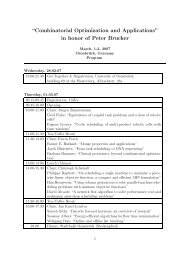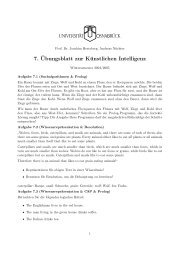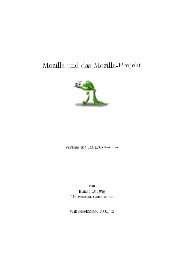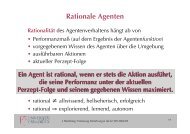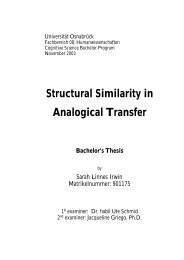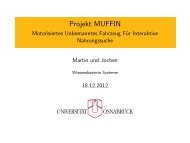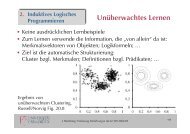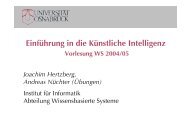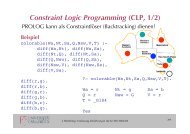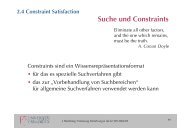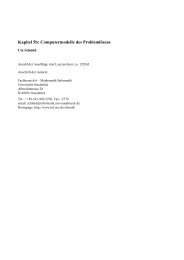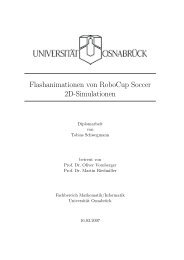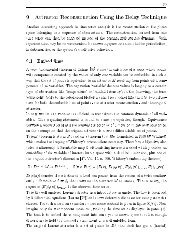Unsupervised Recursive Sequence Processing - Institute of ...
Unsupervised Recursive Sequence Processing - Institute of ...
Unsupervised Recursive Sequence Processing - Institute of ...
You also want an ePaper? Increase the reach of your titles
YUMPU automatically turns print PDFs into web optimized ePapers that Google loves.
from each other. For training and testing we have taken the concatenation <strong>of</strong> randomly<br />
generated words, such preparing sequences <strong>of</strong> 3 · 10 6 and 10 6 input vectors,<br />
respectively. The map has got a map radius <strong>of</strong> 5 and contains 617 neurons on an<br />
hyperbolic grid. For the initialization and the training, the same parameters as in the<br />
previous experiment were used, except for an initially larger neighborhood range <strong>of</strong><br />
14, corresponding to the larger map. Context influence was taken into account by<br />
decreasing η from 1 to 0.8 during training. A number <strong>of</strong> 338 neurons developed a<br />
specialization for Reber strings with an average length <strong>of</strong> 7.23 characters. Figure 5<br />
shows that the neuron specializations produce strict clusters on the circular grid,<br />
ordered in a topological way by the last character. In agreement with the grammar,<br />
the letter T takes the largest sector on the map. The underlying hyperbolic lattice<br />
gives rise to sectors, because they clearly minimize the boundary between the 7<br />
classes. The symbol separation is further emphasized by the existence <strong>of</strong> idle neurons<br />
between the boundaries, which can be seen analogously to large values in a<br />
U-Matrix. Since neuron specialization takes place from the most common states<br />
–which are the 7 root symbols– to the increasingly special cases, the central nodes<br />
have fallen idle after they have served as signposts during training; finally the most<br />
specialized nodes with their associated strings are found at the lattice edge on the<br />
outer ring. Much in contrast to the such ordered hyperbolic target lattice, the result<br />
for the Euclidean grid in figure 7 shows a neuron arrangement in the form <strong>of</strong><br />
polymorphic coherent patches.<br />
Similar to the binary automata learning tasks, we have analyzed the map representation<br />
by the reconstruction <strong>of</strong> the trained data by backtracking all possible context<br />
sequences <strong>of</strong> each neuron up to length 3. Only 118 <strong>of</strong> all 343 combinatorially possible<br />
trigrams are realized. In a ranked table the most likely 33 strings cover all<br />
attainable Reber trigrams. In the log-probability plot 6 there is a leap between entry<br />
number 33 (TSS, valid) and 34 (XSX, invalid), emphasizing the presence <strong>of</strong> the Reber<br />
characteristic. The correlation <strong>of</strong> the probabilities <strong>of</strong> Reber trigrams and their<br />
relative frequencies found in the map is 0.75. An explicit comparison <strong>of</strong> the probabilities<br />
<strong>of</strong> valid Reber strings can be found in figure 8. The values deviate from the<br />
true probabilities, in particular for cycles <strong>of</strong> the Reber graph, such as consecutive<br />
letters T and S, or the VPX-circle. This effect is due to the magnification factor<br />
different from 1 for SOM, which further magnifies when sequences are processed<br />
in the proposed recursive manner.<br />
5.4 Finite memory models<br />
In a final series <strong>of</strong> experiments, we examine a SOM-S trained on Markov models<br />
with noisy input sequence entries. We investigate the possibility to extract temporal<br />
dependencies on real-valued sequences from a trained map. The Markov model<br />
possesses a memory length <strong>of</strong> 2 as depicted in figure 9. The basic symbols are denoted<br />
by a, b, and c. These are embedded in two dimensions, disrupted by noise, as<br />
22





